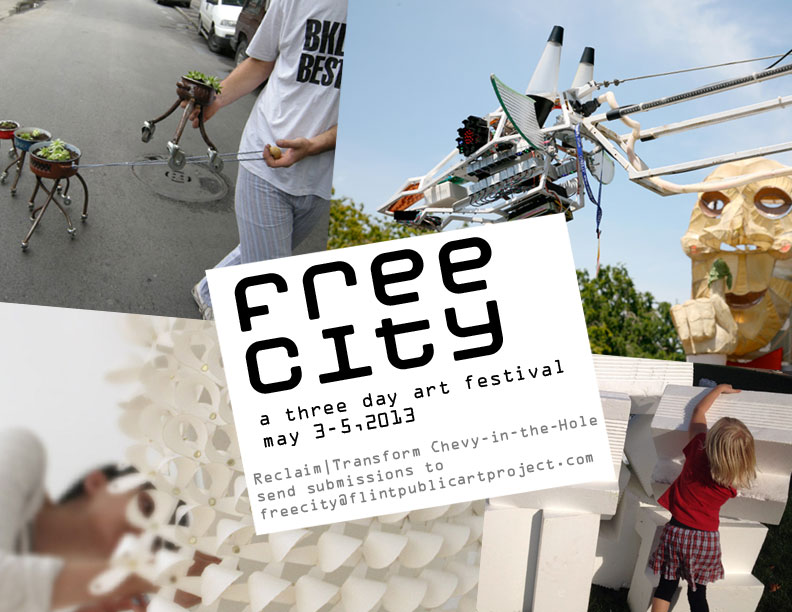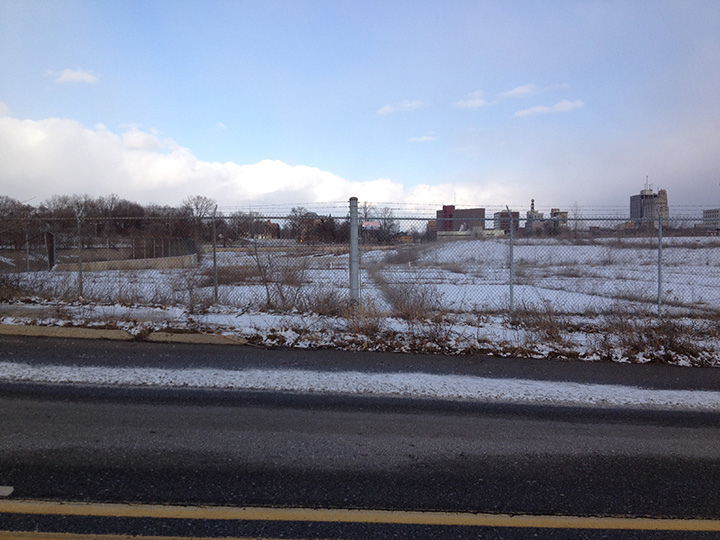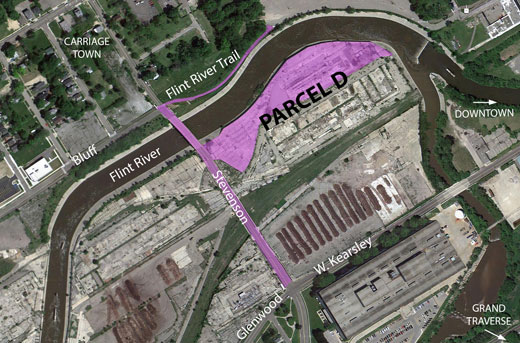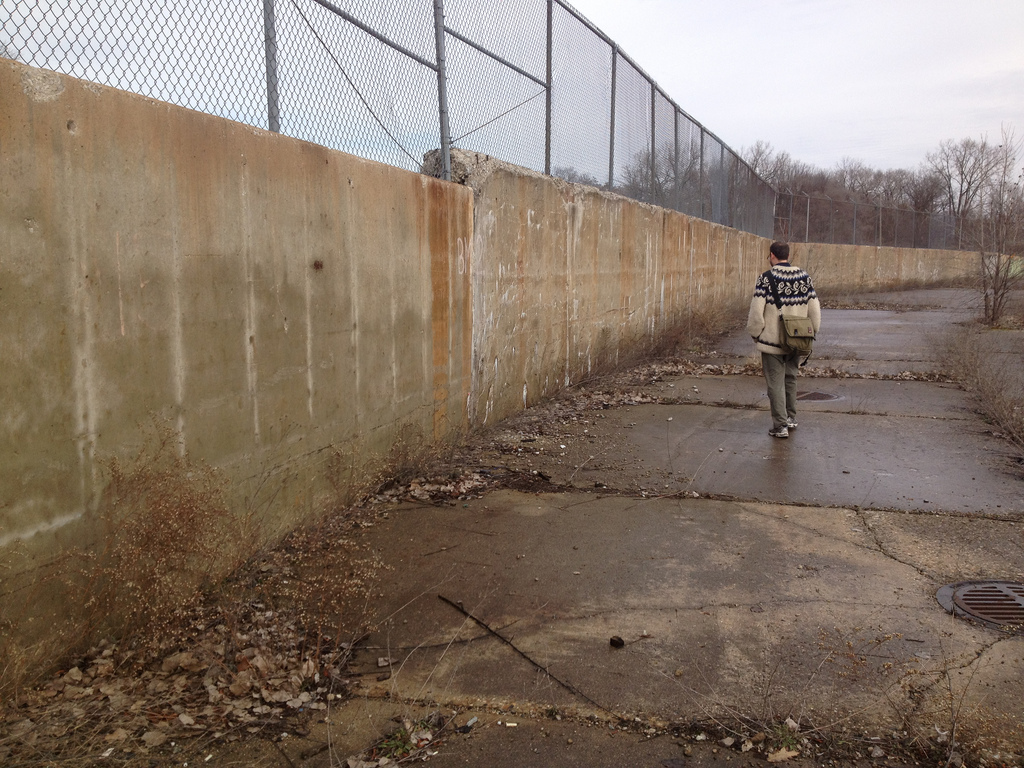By Matthew Morowitz
Photographs (clockwise from upper left): skart, seesaw play-grow (dish familysh), street action, belgrade,
2010, photo by skart; Scott Beale / Laughing Squid; Fermid by Behnaz Babazadeh; J. Chou, FPAP
Flint, Michigan is going through a renaissance of sorts, but instead of a rebirth the city is being reclaimed and transformed. These two ideas are the theme of this spring’s Free City Art Festival, a three-day international public art festival sponsored by the Flint Public Art Project. The call for proposals for the festival is open to anyone, and organizers are looking for a broad range of ideas and activities that extend across a variety of mediums, including and not limited to: video/film projection, installation, interactive environment, performance, mobile application, walking tour, or any other type of temporary event. Yet, while the Flint Public Art Project wants to include as many possible projects and participants, they have to adhere to the festivals four specific requirements:
- Your project addresses the festival theme, Reclaim | Transform, in original, beautiful, inspiring ways.
- Your project is feasible and manageable.
- Your project avoids damaging the site.
- You and your project are resourceful.
The choice of site, Chevy-in-the-Hole, was the former location of the Chevrolet manufacturing facilities. The site is historically significant and was an important part of the economic landscape of the city until the auto industry withdrew the majority of their operations; there are currently about 10,000 GM jobs still in Flint but almost all traces have been removed from the Chevy-in-the-Hole site. In 2004, all but one of the buildings on the site were demolished. Since then, the city of Flint has received funding from the U.S. Department of Agriculture to help rehabilitate the site, planting over 1,000 trees to clean the soil and using part of the area to compost leaf waste and other organic matter. The site occupies a central location in Flint and has visibility from all points of the city, which combined with its historical significance to Flint’s citizens and current environmental initiatives makes Chevy-in-the-Hole the perfect location for this festival as it embodies all the characteristics of the festival’s theme.
AiOP was recently able to talk with Stephen Zacks, the executive director of the Flint Public Art Project about the upcoming festival, the city of Flint, and the organization. The deadline for proposal submissions is March 25th and information on how to submit can be found on the website. All inquiries should be addressed to freecity@flintpublicartproject.com.
AiOP: What inspired the Free City Art Festival?
“Parcel D after a storm” Photo courtesy of Flint Public Art Project.
Zacks: The site itself was the initial inspiration. The idea that there was this expansive landscape that has been outmoded for its previous use for quite a while, since GM demolished the former Chevrolet manufacturing plant there, and for me as someone who grew up in Flint and then came back many years later, it’s just looking at the city for opportunities for possible interventions into the present conditions, possibilities for transformation. You look at this vast landscape that once was dominated by these old, generic GM boxes and you suddenly see this weird, former floodplain where the Flint River curves and it’s kind of a definitive feature of the geography of this city actually that’s revealed by the absence of these factories. We’re just looking at that as an opportunity for this new vision for the site and possibly as a springboard for a new vision of the city that’s emerging through a lot of different processes. When people, especially from outside, look at that site they don’t see the loss of the factory and jobs, they see this great possibility for what could be there. It’s a great opportunity from our perspective.
AiOP: How did you come to the theme Reclaim | Transform?
Zacks: I think that was something that bubbled up to some extent through meetings and the different types of workshops that we’ve been organizing over the past six months with people, but also generally as a part of our mission. On the one hand, it is also the city leadership, mayor Walling being somebody who sees recycling as a good metaphor and practical way of thinking about reusing the city, so that figures into the reclaim part. There are already these large mounds of lawn waste that the city is using for composting on a part of the former factory site, and there is also an initiative by the city with some partners and collaborators. They are planting trees on sections of the site in order to use biological processes in order to reclaim the land from factory pollution. From our point of view, the use of temporary art installations, performances, projection art, and DIY kinds of work is a really quick way to bring a large number of people to this site and activate it for public use so that they can make it into a part of the city again.
“Parcel D fence along Stevenson” Photo courtesy of Flint Public Art Project.
AiOP: Why did you decide Chevy-in-the-Hole as the site of the festival?
Zacks: Part of it is the location; it’s really centrally located and expansive so if you were looking for a place where you could do a large scale public art festival it offers itself as a great location within walking distance of the well-redeveloped downtown center. It’s a few blocks from the renovated historic district, and it’s halfway between the two universities adjacent to the downtown area, and there are lots of restaurants in between. This area is probably regarded as an eyesore, but it’s amazing to walk through and see and think about the possibilities for it.
The other thing that is kind of exciting about it is that as a part of the culture of the city so many people have an historic connection to the place. As we were talking to people about the festival, they’d say ‘oh my father worked there’ or ‘my grandfather worked there’ or ‘I worked there when I was younger’ and they can stand on the site and they can remember exactly where the machine shop was, where the engines were put together, or whatever part of the manufacturing process they were a part of, so it’s really thrilling in a way to give an opportunity for people who have some history of making to become more autonomous makers of something that they imagine or create on the site.
“Free City site map” Photo courtesy of Flint Public Art Project.
In terms of the local history it is best known as the place where the sit-down strike of 1937 happened, which people are very proud of having been central to the formation of the UAW (United Auto Workers), and they’re really a precedent for the first national labor movement, because it set off a series of strikes that were coordinated and resulted in changes in labor laws that improved the quality of life for workers across the country. There is a lot of stuff that we can make use of and part of the ambition of it too is as much as it marks a fairly familiar history of the industrialization for which Flint is well known, and it is probably the only thing Flint is really known for nationally, it’s also a way of bringing all of the things that are present in the surrounding city into this space, a way of showing off that in fact Flint has become already a different place, it’s manifesting the change in that place in an effort to help publicize the new city that is already kind of there.
AiOP: What kinds of changes/dialogues do you hope will come as a result of this festival?
Zacks: We’ve tried to make conversations instrumental to putting together the festival so ideally we’re trying to have conversations with the surrounding neighborhoods and involving them in some fashion in the reuse of that site so they have more of a sense of ownership of it. The other thing that is really nice is that there is this new master plan that’s being conceived now in the city so it figures into that process in an important way in helping through a quick interventionist type of art practice, indicating some gestures towards possible future use that could become adopted into the master plan and into the neighborhoods’ imagining of it.
“Wall along northside of Parcel D” Photo courtesy of Flint Public Art Project.
AiOP: What impact do you think this festival will have for the Flint Public Art Project?
Zacks: I hope that it will be good for us and for the city, broadening the national and international scope, helping to make the argument about the role of public art, design, and architecture in city making, because we feel like there’s a larger, national agenda to be made for moving cultural capitol out of highly-concentrated cosmopolitan centers into places where it could have a larger impact. We’re kind of an odd organization in that we’re based partially in Brooklyn and our work is in Flint more than half the time, probably three quarters of the time. We’re motivated in part by the effort to improve the artistic, cultural life of Brooklyn by stopping having art continually inflate real estate prices in our surrounding in this odd kind of counterproductive aspect of cultural production that happens where you already have this inflated value and it’s just causing these new ceilings to be constantly blown out of real estate values. We’re trying to argue for a more sustainable model of cultural production.
“Looking east across Parcel D” Photo courtesy of Flint Public Art Project.







